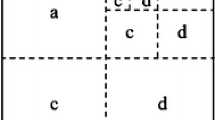Abstract
Human social relationships are a key component of emerging complex techno-social systems such as socially-centric platforms based on the interactions between humans and ICT technologies. Therefore, the models of human social relationships are fundamental to characterise these systems and study the performance of socially-centric platforms depending on the social context where they operate. The goal of this paper is presenting a generative model for building synthetic human social network graphs where the properties of social relationships are accurately reproduced. The model goes well beyond a binary approach, whereby edges between nodes, if existing, are all of the same type. It sets the properties of each social link, by incorporating fundamental results from the anthropology literature. The synthetic networks it generates accurately reproduce both the macroscopic structure (e.g., its diameter and clustering coefficient), and the microscopic structure (e.g., the properties of the tie strength of individual social links) of human social networks. We compare generated networks with a large-scale social network data set, validating that the model is able to produce graphs with the same structural properties of human-social-network graphs. Moreover, we characterise the impact of the model parameters on the synthetic graph properties.
Access this chapter
Tax calculation will be finalised at checkout
Purchases are for personal use only
Preview
Unable to display preview. Download preview PDF.
Similar content being viewed by others
References
Conti, M., et al.: Looking ahead in pervasive computing: Challenges and opportunities in the era of cyber-physical convergence. Pervasive and Mobile Computing 8(1), 2–21 (2012)
Conti, M., Passarella, A., Pezzoni, F.: A model for the generation of social network graphs. In: 2011 IEEE International Symposium on a World of Wireless, Mobile and Multimedia Networks (WoWMoM), pp. 1–6 (June 2011)
Granovetter, M.: The strength of weak ties. American Journal of Sociology, 1360–1380 (1973)
Onnela, J.P., Arbesman, S., Gonzáez, M.C., Barabási, A.L., Christakis, N.A.: Geographic constraints on social network groups. PLoS ONE 6(4), e16939 (2011)
Roberts, S.G., et al.: Exploring variation in active network size: Constraints and ego characteristics. Social Networks 31(2), 138–146 (2009)
Zhou, W.X., Sornette, D., Hill, R.A., Dunbar, R.I.M.: Discrete hierarchical organization of social group sizes. Proceedings of the Royal Society B: Biological Sciences 272(1561), 439–444 (2005)
Dunbar, R.I.M.: The social brain hypothesis. Evolutionary Anthropology: Issues, News, and Reviews 6(5), 178–190 (1998)
Hill, R.A., Dunbar, R.I.M.: Social network size in humans. Human Nature 14(1), 53–72 (2003)
Roberts, S., Dunbar, R.: Communication in social networks: Effects of kinship, network size, and emotional closeness. Personal Relationships 18(3), 439–452 (2011)
Dunbar, R.I.M., Spoors, M.: Social networks, support cliques, and kinship. Human Nature 6(3), 273–290 (1995)
Travers, J., Milgram, S.: An Experimental Study of the Small World Problem. Sociometry 32(4), 425 (1969)
Sutcliffe, A., Dunbar, R., Binder, J., Arrow, H.: Relationships and the social brain: Integrating psychological and evolutionary perspectives. British Journal of Psychology 103(2), 149–168 (2012)
Watts, D.J., Strogatz, S.H.: Collective dynamics of ’small-world’ networks. Nature 393(6684), 440–442 (1998)
Ugander, J., Karrer, B., Backstrom, L., Marlow, C.: The Anatomy of the Facebook Social Graph. CoRR abs/1111.4 (2011)
Mislove, A., Marcon, M., Gummadi, K.P., Druschel, P., Bhattacharjee, B.: Measurement and analysis of online social networks. In: Proceedings of the 7th ACM SIGCOMM Conference on Internet Measurement, IMC 2007, vol. 40(6), p. 29 (2007)
Wilson, et al.: User interactions in social networks and their implications. In: Proceedings of the 4th ACM European conference on Computer systems, EuroSys 2009, pp. 205–218. ACM, New York (2009)
Gonçalves, B., Perra, N., Vespignani, A.: Validation of dunbar’s number in twitter conversations. CoRR abs/1105.5170 (2011)
Teutle, A.: Twitter: Network properties analysis. In: 2010 20th International Conference on Electronics, Communications and Computer (CONIELECOMP), pp. 180–186 (February 2010)
Arnaboldi, V., Conti, M., Passarella, A., Pezzoni, F.: Analysis of ego network structure in online social networks. Technical Report IIT-CNR TR-10-2012 (2012), http://www.iit.cnr.it/sites/default/files/TR-10-2012.pdf
Lee, S.H., Kim, P.J., Jeong, H.: Statistical properties of sampled networks (2009)
Author information
Authors and Affiliations
Editor information
Editors and Affiliations
Rights and permissions
Copyright information
© 2012 Springer-Verlag Berlin Heidelberg
About this paper
Cite this paper
Conti, M., Passarella, A., Pezzoni, F. (2012). A Model to Represent Human Social Relationships in Social Network Graphs. In: Aberer, K., Flache, A., Jager, W., Liu, L., Tang, J., Guéret, C. (eds) Social Informatics. SocInfo 2012. Lecture Notes in Computer Science, vol 7710. Springer, Berlin, Heidelberg. https://doi.org/10.1007/978-3-642-35386-4_14
Download citation
DOI: https://doi.org/10.1007/978-3-642-35386-4_14
Publisher Name: Springer, Berlin, Heidelberg
Print ISBN: 978-3-642-35385-7
Online ISBN: 978-3-642-35386-4
eBook Packages: Computer ScienceComputer Science (R0)




